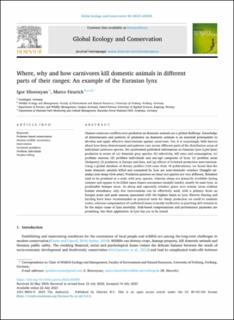| dc.contributor.author | Khorozyan, Igor | |
| dc.contributor.author | Heurich, Marco Dietmar | |
| dc.date.accessioned | 2023-09-21T09:27:54Z | |
| dc.date.available | 2023-09-21T09:27:54Z | |
| dc.date.created | 2023-09-05T09:57:01Z | |
| dc.date.issued | 2023 | |
| dc.identifier.citation | Global Ecology and Conservation. 2023, 46 . | en_US |
| dc.identifier.issn | 2351-9894 | |
| dc.identifier.uri | https://hdl.handle.net/11250/3091020 | |
| dc.description.abstract | Human-carnivore conflicts over predation on domestic animals are a global challenge. Knowledge of determinants and patterns of predation on domestic animals is an essential prerequisite to develop and apply effective interventions against carnivores. Yet, it is surprisingly little known about how these determinants and patterns vary across different parts of the distribution areas of individual carnivore species. We synthesized published information on Eurasian lynx (Lynx lynx) predation in terms of: (a) domestic prey species, (b) selectivity, kill rates and consumption; (c) problem seasons; (d) problem individuals and sex/age categories of lynx; (e) problem areas (hotspots); (f) predation in Europe and Asia; and (g) effects of livestock protection interventions. Using a global database of dietary profiles (104 cases from 39 publications), we found that the
main domestic animals killed and consumed by lynx are semi-domestic reindeer (Rangifer tarandus) and sheep (Ovis aries). Predation patterns on these two species are very different. Reindeer tend to be predated as a main wild prey species, whereas sheep are primarily available during summer and appear to be killed upon chance encounters (mainly lambs), mostly by male lynx, in predictable hotspot areas. As sheep and especially reindeer graze over remote areas without human attendance, only few interventions can be effectively used, with a primary focus on hotspot areas and peak seasons associated with the highest losses to lynx. Electric fencing and herding have been recommended as practical tools for sheep protection on small to medium
scales, whereas compensation of confirmed losses is mostly ineffective as poaching still remains to be the major cause of lynx mortality. Risk-based compensations and performance payments are promising, but their application in lynx has yet to be tested. | en_US |
| dc.language.iso | eng | en_US |
| dc.rights | Attribution-NonCommercial-NoDerivatives 4.0 Internasjonal | * |
| dc.rights.uri | http://creativecommons.org/licenses/by-nc-nd/4.0/deed.no | * |
| dc.subject | evidence-based conservation | en_US |
| dc.subject | human-wildlife coexistence | en_US |
| dc.subject | intervention | en_US |
| dc.subject | livestock predation | en_US |
| dc.subject | problem individuals | en_US |
| dc.subject | surplus killing | en_US |
| dc.title | Where, why and how carnivores kill domestic animals in different parts of their ranges: An example of the Eurasian lynx | en_US |
| dc.type | Peer reviewed | en_US |
| dc.type | Journal article | en_US |
| dc.description.version | publishedVersion | en_US |
| dc.rights.holder | © 2023 The Author(s). | en_US |
| dc.subject.nsi | VDP::Landbruks- og Fiskerifag: 900 | en_US |
| dc.source.pagenumber | 15 | en_US |
| dc.source.volume | 46 | en_US |
| dc.source.journal | Global Ecology and Conservation | en_US |
| dc.identifier.doi | 10.1016/j.gecco.2023.e02585 | |
| dc.identifier.cristin | 2172369 | |
| cristin.ispublished | true | |
| cristin.fulltext | original | |
| cristin.qualitycode | 1 | |

